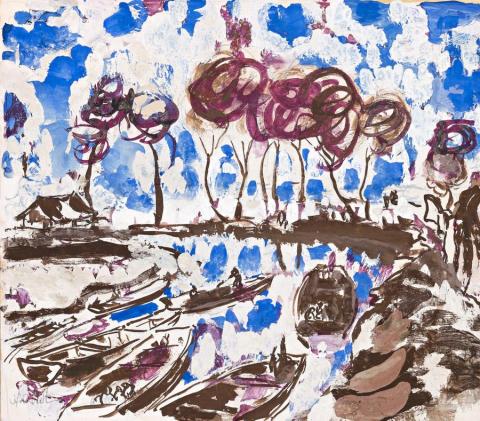HANGCHOW CANAL, 1945-47
IAN FAIRWEATHER
watercolour, gouache and crayon on paper
37.0 x 41.0 cm
signed lower left: Fairweather
The Redfern Gallery, London
Wilfrid A. Evill, London, acquired from the above in 1948
Thence by descent
Honor Frost, London, 1963
Sotheby's, London, The Evill/Frost Collection, 16 June 2011, lot 142
Company collection, London
Patrick Heron – Ian Fairweather, The Redfern Gallery, London, 28 October – 20 November 1948, cat. 29 (label attached verso)
Pictures, Drawings, Water Colours and Sculpture, The Home of Wilfrid A. Evill, Contemporary Art Society, London, April – May 1961 (part IV – section 4) cat. 5
The Wilfrid Evill Memorial Exhibition, Brighton Art Gallery, Brighton, June – August 1965, cat. 32 (lent by Miss H Frost, label attached verso)
London to Sydney, Agnew's Gallery at Rex Irwin Art Dealer, Sydney, 8–19 November 2011, cat. 26 (label attached verso)
London to Sydney, Agnew's Gallery, London, 2011, pp. 6–7 (illus.)
Ian Fairweather's two periods in China from 1929 to 1933 and again in 1935-36 so influenced his thought and style, it resulted in that fascinating blend of East and West that enriches his art. The oil on paper Temple, West Lake, Hangchow, 1936, in the collection of James Fairfax, Sydney, is one of the finest of his Hangchow subjects. Other important examples include (River, Hangchow), 1941, gouache and pencil on paper, National Gallery of Australia, Canberra, and River at Hangchow, 1945-47 sold at Deutscher and Hackett in November 2010. For brevity and beauty among his Chinese subjects, none can rival Bridge, Huchow, 1941, National Gallery of Victoria, Melbourne, of gouache, pencil and ink on paper, brilliantly essayed in blues and browns. In addition to those works completed in China and on his journeys, memories and sketches were the source of works completed in later years. Hangchow Canal, 1945-47 was painted while Fairweather was living and working in Melbourne. It was subsequently included in his London exhibition at the Redfern Gallery in 1948. As in the best of these works, it shows that brevity of statement that espouses a depth of meaning, of images noted with calligraphic freedom, realized through a restricted but beautiful palette. Illustrating the profoundly beneficial influence the Chinese master calligraphers had on his work at this time, Fairweather said the masters could make 'a few strokes of the brush, dramatic, delicate and with a tremendous power of suggestion and imagination'.1
Throughout the centuries the legendary city of Hangchow (Chinese Hangzhou) has been so admired as a place of such beauty that it is celebrated in the Chinese saying, 'In heaven there is paradise; on earth Soochow and Hangchow.'2 The thirteenth-century Venetian merchant-adventurer Marco Polo described it as 'beyond dispute the finest and the noblest in the world.' Prominent on the Yangtze River Delta, it is renowned throughout China not only for its natural beauty, but also for its relics of history, and for its prosperity. West Lake with its historical pagodas and rolling hills is nowadays recognized as a World Heritage Site. The Grand Canal itself, over two thousand years old, is another wonder and vital commercial lifeline. Stretching from Hangchow to Beijing, it is the longest manmade waterway in the world. Teeming with life, Fairweather captures its mood and pulse through the application of paint, dancing across the paper surface, a liquid pattern of light and reflection. The seeming speed with which the paint has been applied is in itself a metaphor of the canal and Hangchow the city it serves.
1. Ian Fairweather, quoted in, Bail, M., Fairweather, Murdoch Books, Sydney, 2009 edition, p. 46
2. Ibid, p. 51
DAVID THOMAS
